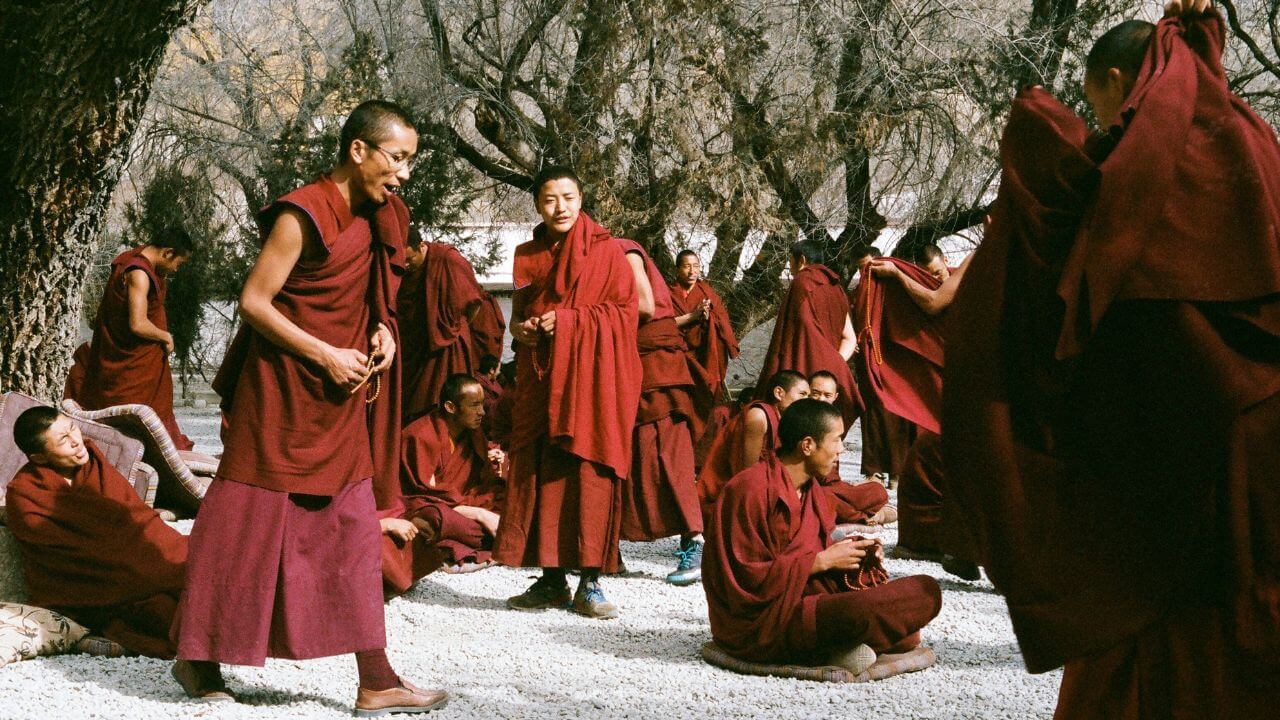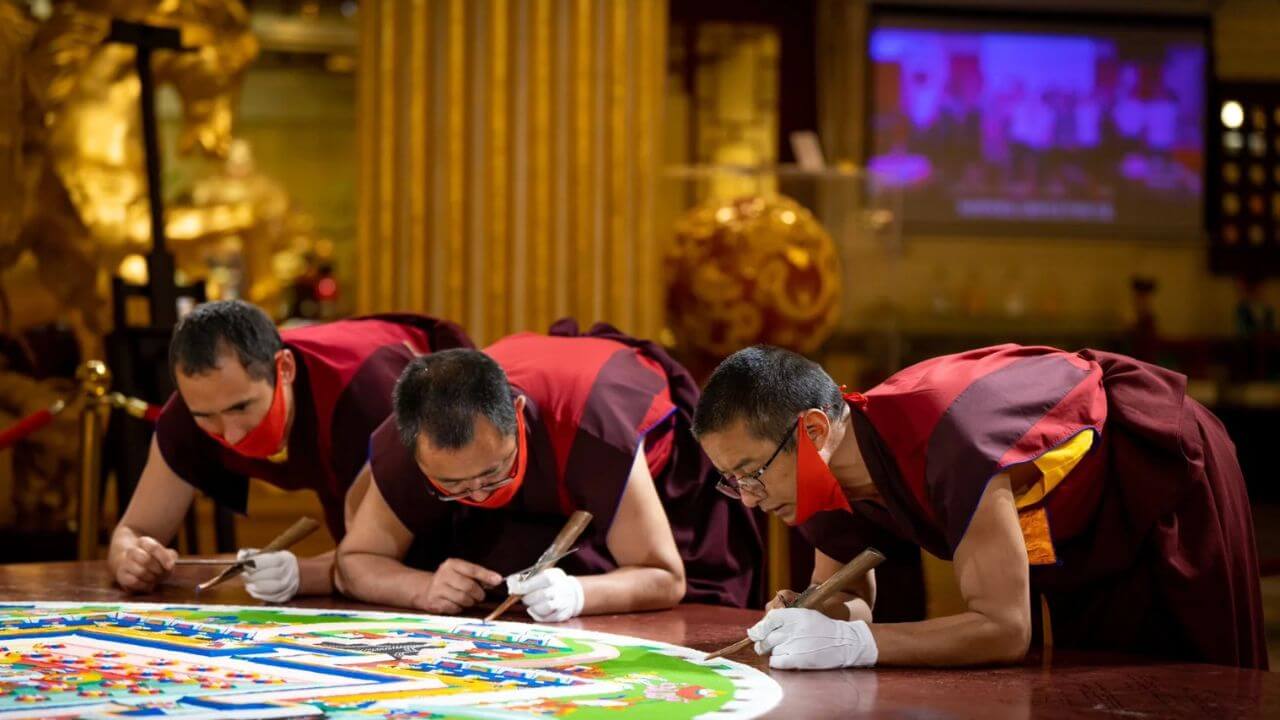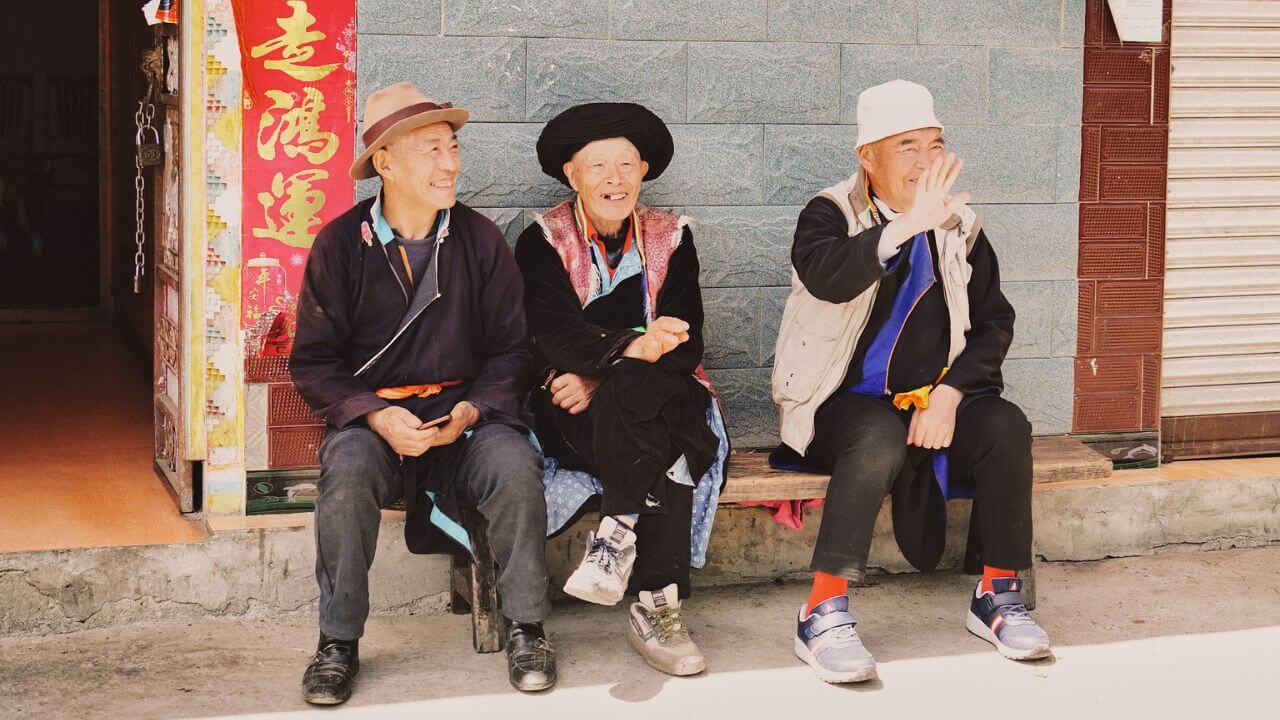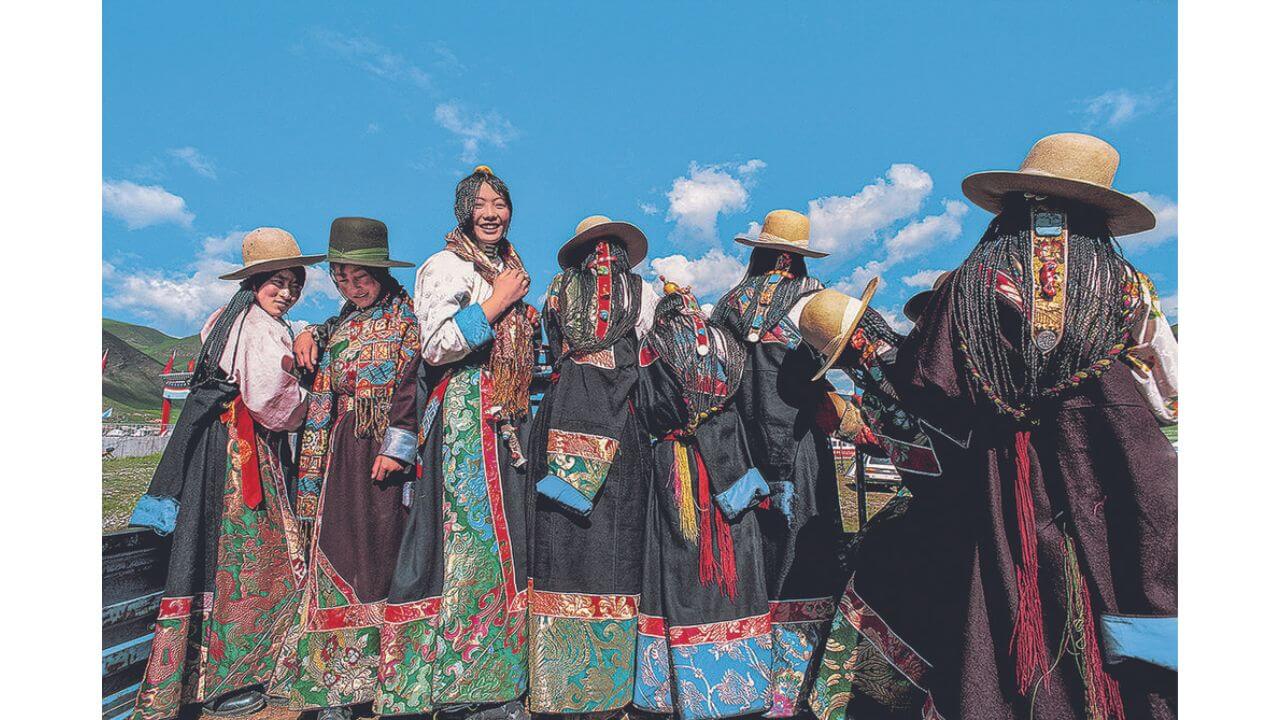Tibet has many customs and traditions, and it is a mixture of history and spiritual practices. Understanding and respecting their customs and traditions will help you enjoy your visit more.
I always recommend learning some of the customs and traditions of every place you visit, especially in places rich with culture and traditions like Tibet.
If you want to go deeply in Tibet customs, cuisine, what to do in Tibet, read the Tibet Travel Guide.

“Tibetan customs and traditions create a rich tapestry of ancient rituals and vibrant culture, giving a deep look into the timeless spirit of the Himalayas.”
Tibetan Buddhism
Tibetan Buddhism is central to life in Tibet, deeply influencing its culture, traditions, and daily practices. Here’s a closer look at its spiritual practices, monastic life, and other beliefs in Tibet.
Spiritual Practices
Monasteries: Monasteries are the heart of Tibetan Buddhism. They serve as places of worship, learning, and community gatherings. Important monasteries include the Jokhang Temple and the Drepung Monastery.
Prayer Flags: These colorful flags are often seen fluttering in the wind. Each color represents an element, and the flags are believed to spread prayers and blessings with the wind.
Prayer Wheels: Spinning prayer wheels, filled with scrolls of mantras, is a common practice. Each spin is believed to release prayers and accumulate good karma.
Pilgrimages: Pilgrimage to sacred sites like Mount Kailash and Jokhang Temple is a significant religious activity. Pilgrims often perform prostrations, bowing down and lying flat on the ground, to show devotion and seek spiritual merit.
Meditation: Meditation is a core practice, helping followers achieve inner peace and spiritual insight. Many people meditate daily, either at home or in special meditation centers.
Monastic Life
Roles of Monks and Nuns: Monks and nuns are highly respected in Tibetan society. They devote their lives to studying Buddhist texts, practicing meditation, and performing rituals. They also engage in community service and education.
Education: Monastic education is rigorous, involving the study of scriptures, philosophy, and debates. Monks often undergo many years of training.
Community Involvement: Monks and nuns play a vital role in their communities, offering spiritual guidance, performing religious ceremonies, and helping with social and charitable activities.
Respect and Conduct: Visitors to monasteries should dress modestly and behave respectfully. This includes not disturbing the monks or their practices and following any specific guidelines provided.

Other Beliefs in Tibet
Bon Religion: Before Buddhism, Bon was the primary religion in Tibet. It shares many similarities with Tibetan Buddhism but has distinct rituals and beliefs. Bon practices still exist today, often blending with Buddhist traditions.
Animism and Shamanism: Many Tibetans also believe in animism, the idea that all things in nature, such as mountains, rivers, and trees, possess a spirit. Shamans, or spiritual healers, play a role in communicating with these spirits and conducting rituals for protection and healing.
Oracles and Divination: Oracles, who are believed to be able to communicate with deities and spirits, are consulted for important decisions and during times of trouble. Divination practices, such as consulting astrological charts and using dice or prayer beads, are also common.
Symbols and Art
Symbols are a vital part of Tibetan customs and traditions, filled with colors and majestic art.
Thangkas: Thangkas are intricate paintings on silk or cotton, depicting Buddhist deities, scenes from the life of Buddha, and mandalas. They are used in rituals and as meditation aids.
Mandalas: Mandalas are geometric designs symbolizing the universe. Creating sand mandalas is a significant spiritual practice, representing the impermanence of life.
Stupas: Stupas are religious monuments that house sacred relics. They are sites of pilgrimage and meditation, often surrounded by prayer wheels and flags.

Language and Greetings
Understanding the language and common greetings in Tibet can greatly enhance your experience and help you connect with the local people. Here’s a deeper look into the linguistic landscape and the etiquette of greetings in Tibet.
Language
Tibetan Language
Tibetan is the main language spoken in Tibet, with several dialects across different regions. The Central Tibetan dialect, also known as Lhasa Tibetan, is the most widely understood.
Script: Tibetan script is unique and derived from an ancient Indian script. It is used in religious texts, official documents, and everyday writing.
Mandarin Chinese
Mandarin Chinese is also widely spoken in Tibet, especially in urban areas and among younger generations. Many Tibetans are bilingual, speaking both Tibetan and Mandarin.
Knowing some basic Mandarin can be useful, especially when dealing with government offices, larger businesses, or when traveling to more urban areas.
Greetings
Tashi Delek
Meaning: “Tashi Deleg” (བཀྲ་ཤིས་བདེ་ལེགས།) is the most common greeting in Tibet, meaning “good luck” or “blessings.” It is used in both formal and informal settings. This greeting can be used at any time of the day and is a friendly way to initiate a conversation.
Body Language
Palms Together: Placing your palms together in front of your chest, similar to a prayer gesture, is a respectful way to greet someone. It shows humility and respect.
Slight Bow: A slight bow of the head or body, along with the palms together gesture, adds an extra layer of respect, especially when greeting elders or monks.
Respectful Address
Titles and Honorifics: When addressing someone, it’s respectful to use appropriate titles and honorifics. For example, calling a monk “Lama” (teacher) or adding “-la” at the end of a name to show respect (e.g., Tenzin-la).
Avoiding Touch: Physical contact, such as shaking hands, is less common in Tibetan culture. It’s best to follow the lead of the person you are greeting.
Common Courtesy
Smiling: A genuine smile goes a long way in Tibet. It is seen as a sign of friendliness and goodwill.
Patience: Being patient and respectful in interactions, even if there is a language barrier, helps build positive relationships. Using simple gestures and maintaining a calm demeanor is appreciated.

Cultural Sensitivity
Learning and Listening: Showing interest in the Tibetan language and culture by learning a few phrases and listening attentively when people speak is highly appreciated. It demonstrates respect and a willingness to engage.
Avoiding Misunderstandings: Be aware of cultural differences in communication. For example, pointing with a finger or touching someone’s head can be seen as disrespectful.
Respect for Religion: When greeting monks or entering religious sites, be particularly mindful of your behavior. Dress modestly, speak softly, and follow any specific rules or customs.
Dress and Attire
Traditional Clothing: Traditional clothing is often worn, especially during festivals. Men wear a long robe called a “chuba,” and women wear similar dresses with colorful aprons called “pangden.”
Hats and Accessories: Hats are important and vary by region. Jewelry made of turquoise, coral, and silver is common and symbolizes status and protection.

Festivals and Celebrations
Tibetans have many festivals and celebrations, you can read and learn more about them before you visit some of the many festivals.
These three are the most celebrated and most popular festivals.
Losar: The Tibetan New Year, or Losar, is the biggest festival. It includes rituals, dances, and feasts, with families honoring deities and ancestors.
Saga Dawa: This festival marks the birth, enlightenment, and death of Buddha. People engage in religious activities and make offerings.
Shoton Festival: Known as the Yogurt Festival, it features Tibetan opera and the unveiling of giant paintings called thangkas at monasteries.
Continue reading about Things to Do in Tibet.

Helen Wang
Travel Advisor & Guide Expert
I started my travel career in 2005 and have since become an expert in Tibet and China’s travel destinations and helping travelers plan unforgettable trips.
For expert travel advice to China or Tibet, feel free to contact me.